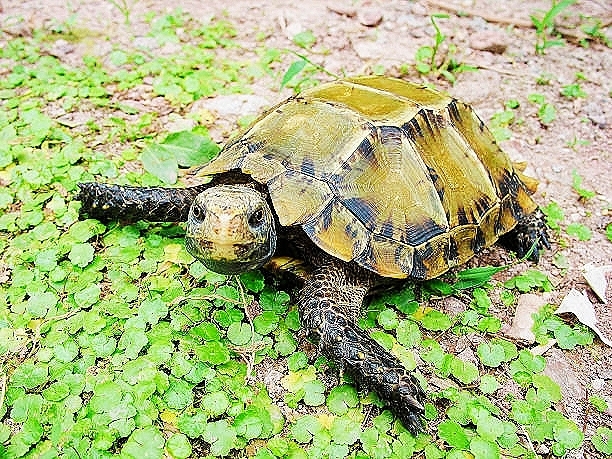Impressed tortoise (Manouria impressa) The impressed tortoise Manouria impressa is one of just 4 species of native land tortoise occurring in Southeast Asia. This is the smaller of two species of the genus Manouria, the other being the larger Asian giant tortoise Manouria emys.
In evolutionary terms, tortoises of the genus Manouria are considered to show primitive characteristics.
The impressed tortoise inhabits humid, moist hill and montane forest up to elevations of at least 1300 metres, though the precise altitudinal range appears confused in the literature.
This is considered to be a rare species, which is threatened by poaching for traditional medicine and for the pet trade, even though they are notoriously difficult to keep alive in captivity.
The curious name of this species refers not to its expression or demeanour, rather to the concave nature of the scutes (i.e. the scales) which comprise its markedly flat carapace. The marginal scutes at the rear of the animal are serrated, and in some specimens the three frontal scutes above the head and neck (the middle of which is the nuchal scute) are elongated, which provides additional protection to the top of the head.
The carapace is orange-brown to dark brown in colour, and individual scutes typically have darker margins.
The front limbs are adorned with stiff, elongate scales. The head is yellow to cream, with pink markings: male specimens reportedly have darker heads.
The species has been well documented feeding on mushrooms, which appear to comprise the bulk of its diet. Other dietary ingredients might include grasses such as bamboo.
A study of the species in Phu Luang Wildlife Sanctuary, Thailand showed a small home range of no greater than 17.7 hectares, and generally considerably less. Thus, these tortoises appear to live in very localized areas of forest.
Females are larger than males, and they lay around 20 or so eggs in a shallow scrape, which is then covered with a mound of leaf litter and some loose soil. The female will defend this nesting site as far as possible from predators such as monitor lizards.
This rarely encountered tortoise occurs in parts of eastern Myanmar, Thailand, Laos, Cambodia, Vietnam and northern Peninsular Malaysia.
